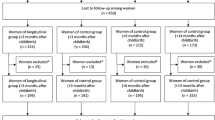Abstract
The objective of this study was to explore pregnant and recently pregnant women’s perceptions of influenza vaccine and antivirals during the 2009 H1N1 pandemic. We conducted 18 focus groups with pregnant and recently pregnant women in three US cities in September 2009. Participants were segmented into groups by insurance status (no or public insurance vs. private insurance), vaccine attitudes (higher vs. lower likelihood of acceptance of any vaccines, not only influenza vaccines), and parity (first child vs. other children in the home) based on information they provided on the screening questionnaire at the time of recruitment. We found that women are not well informed about influenza vaccinations and antiviral medicine and have significant concerns about taking them during pregnancy. An interest in their infant’s well-being, however, can be strong motivation to adopt preventive recommendations, including vaccination. A woman’s health care provider is a highly trusted source of information about the 2009 H1N1. Pregnant women have unique communication needs for influenza. Messages directing pregnant women to adopt public health recommendations, particularly for vaccination or prophylactic medication should include a detailed description of the benefits or lack of risk to the fetus and the safety of breastfeeding. Additionally, messages should recognize that pregnant women are taught to be selective about taking medication and provide a clear rationale for why the medicine or vaccine is necessary.

Similar content being viewed by others
Notes
Quantitative results are intended to provide context and a point of reference and are not statistically significant.
References
Centers for Disease Control and Prevention. (1999). Office of Minority Health and Health Disparities. Eliminate disparities in infant mortality. Atlanta: CDC. Available from: http://www.cdc.gov/omhd/AMH/factsheets/infant.htm. cited March 23, 2009.
Farrell, R. M., & Beigi, R. H. (2009). Pandemic influenza and pregnancy: an opportunity to reassess maternal bioethics. American Journal of Public Health, 99(Suppl 2), S231–S235.
Hayes, C. E. (2008). Prevention of influenza. Journal of Midwifery and Womens Health, 53(3), 268–271.
Tamma, P. D., Ault, K. A., del Rio, C., Steinhoff, M. C., Halsey, N. A., & Omer, S. B. (2009). Safety of influenza vaccination during pregnancy. American Journal of Obstetrics and Gynecology, 201(6), 547–552.
Naleway, A. L., Smith, W. J., & Mullooly, J. P. (2006). Delivering influenza vaccine to pregnant women. Epidemiologic Reviews, 28, 47–53.
Rasmussen, S. A., Jamieson, D. J., & Bresee, J. S. (2008). Pandemic influenza and pregnant women. Emerging Infectious Diseases, 14(1), 95–100.
Rebmann, T. (2008). Preparing for pandemic influenza. The Journal of Perinatal and Neonatal Nursing, 22(3), 191–202. quiz 3–4.
Siston, A. M., Rasmussen, S. A., Honein, M. A., Fry, A. M., Seib, K., Callaghan, W. M., et al. (2010). Pandemic 2009 influenza A(H1N1) virus illness among pregnant women in the United States. Journal of American Medical Association, 303(15), 1517–1525.
Jamieson, D. J., Honein, M. A., Rasmussen, S. A., Williams, J. L., Swerdlow, D. L., Biggerstaff, M. S., et al. (2009). H1N1 2009 influenza virus infection during pregnancy in the USA. Lancet, 374(9688), 451–458.
Fiore AE, Shay DK, Broder K, Iskander JK, Uyeki TM, Mootrey G, et al. (2009). Prevention and control of seasonal influenza with vaccines: recommendations of the Advisory Committee on Immunization Practices (ACIP), 2009. Morbidity and Mortality weekly Recommendations and Reports. 58(RR-8):1–52.
Harris Interactive. (2008). Flu shot & pregnancy survey report. Red Bank (NJ): The National Women’s Health Resource Center.
Tong, A., Biringer, A., Ofner-Agostini, M., Upshur, R., & McGeer, A. (2008). A cross-sectional study of maternity care providers’ and women’s knowledge, attitudes, and behaviours towards influenza vaccination during pregnancy. Journal of Obstetrics and Gynaecology Canada, 30(5), 404–410.
Gerber, J. S., & Offit, P. A. (2009). Vaccines and autism: A tale of shifting hypotheses. Clinical Infectious Diseases, 48(4), 456–461.
Wallis, D. H., Chin, J. L., Sur, D. K., & Lee, M. Y. (2006). Increasing rates of influenza vaccination during pregnancy: A multisite interventional study. Journal of the American Board of Family Medicine, 19(4), 345–349.
Rogers, R. W. (1975). A protection motivation theory of fear appeals and attitude change. Journal of Psychology, 91, 93–114.
Patton, M. Q. (2002). Qualitative research and evaluation methods (3rd edn ed.). Thousand Oaks (CA): Sage.
Krueger, R. A., & Casey, M. A. (2000). Focus groups: A practical guide for applied research. Thousand Oaks (CA): Sage.
Fridman, D, Steinberg E, Azhar E, Weedon J, Wilson TE. (2011). Predicators of H1N1 vaccination in pregnancy. American Journal of Obstetrics and Gynecology. 204(6)S1:S124–127.
Centers for Disease Control and Prevention. (2009). H1N1 vaccination recommendations. Atlanta: CDC. Available from: http://www.cdc.gov/h1n1flu/vaccination/acip.htm.
U.S. Public Health Service. (1995). Risk communication: working with individuals and communities to weigh the odds. Prevention report. Washington, DC: U.S. Department of Health and Human Services, Public Health Service. Available from: http://odphp.osophs.dhhs.gov/pubs/prevrpt/Archives/95fm1.htm. cited December 17, 209.
Acknowledgments
The authors wish to thank Kitty MacFarlane of the CDC and Colleen Carr and Laurie Brockman of Danya International for their contributions to the development and review of this manuscript. We also wish to thank Jackie Amoozegar, Joey Horne, and Genny Cromwell of RTI International for their analytic support. The research was funded under a contract with the Centers for Disease Control and Prevention No. 0210637 Task Order 9.
Author information
Authors and Affiliations
Corresponding author
Additional information
The findings and conclusions in this report are those of the authors and do not necessarily represent the official position of the Centers for Disease Control and Prevention.
Rights and permissions
About this article
Cite this article
Lynch, M.M., Mitchell, E.W., Williams, J.L. et al. Pregnant and Recently Pregnant Women’s Perceptions about Influenza A Pandemic (H1N1) 2009: Implications for Public Health and Provider Communication. Matern Child Health J 16, 1657–1664 (2012). https://doi.org/10.1007/s10995-011-0865-y
Published:
Issue Date:
DOI: https://doi.org/10.1007/s10995-011-0865-y




